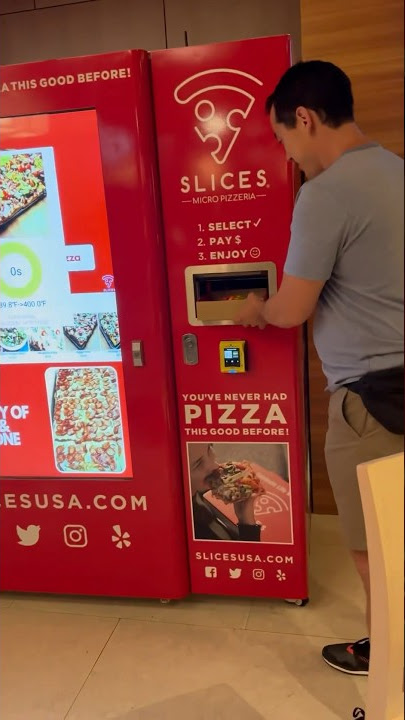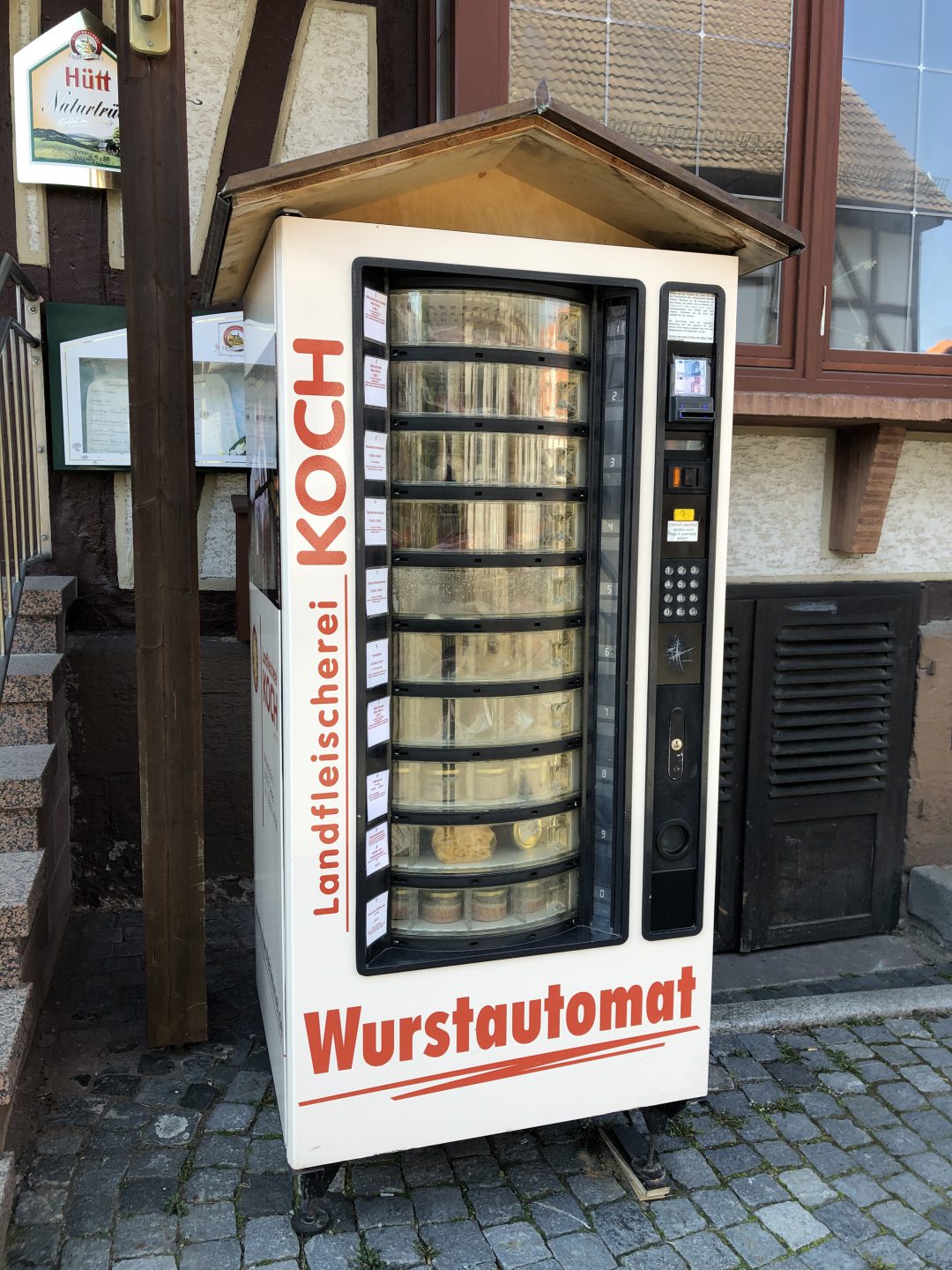with supply and demand and all… IM DEMANDING CANNED BREAD!! where’s the supply 🥺?
It replaces workers with robots so it would probably save money too.
I just saw a book vending machine in an elementary school this weekend…I thought that was kind of cool.
Yeah we have those outside!

There are little free library boxes everywhere in my town!
Sometimes those vending machines are very unsanitary and would not pass health regulations here in the US.
My boss once said that you can abuse human workers, you can underpay them, you can worsen their conditions (and if you do it slowly) they might not notice, or they going to work even harder to survive. Worst case scenario they quit, and you just find another one “new” and repeat the cycle.
But you can’t underpay robots. You can’t abuse them. Why? Because they just break. You skip on maintenance, on working conditions, on anything around robots - and you are looking on fat sum of money that just going to get burnt on a new robot and its installation.
So no, robots are not going to save money, especially in this scenario, because abuse would be massive.
Except robots don’t need to take as many breaks nor do you have to pay them minimum wage.
You have to pay them minimum wage, It’s just called “monthly maintenance expenses” and it’s quite a bit more than minimum pay for humans
and it’s quite a bit more than minimum pay for humans
Is it? I can buy a vending machine for less than $8000. Converting that cost to minimum wage, that is ~28 full time weeks worth of labor to act as a mechanism to sell items. There are probably a lot of times when the cost in capital is less than the cost in labor.
The problem is minimum wage is the break even equivalent of like 2-10k human hours without even factoring in expensive maintenance costs.
A return on investment of 0.5 to 2.5 years is pretty good for companies. You also have to factor the costs of maintaining a space for a human equivalent. Paying a wage doesn’t cover all labor costs.
I mean, maintenance is going to be a bitch. Your going to have to pay thousands in travel fees and probably thousands of dollars an hour labor, plus whatever robit parts cost everytime it breaks down. And while it’s broken down, you can’t earn revenue, like you could just replacing an employee.
You do actually have to pay them more than minimum wage, if you think about it.
Minimum wage in many countries is so low it’s not enough to sustain a human. You can’t do it to a robot, since it will just not do its job, no matter how many regulators you capture or how many middle management manipulations you pull. You have to pay a living wage to a robot.
This is why “people are still cheaper than robots”. What happens if there’s a 20% wave of inflation? With workers, it’s “we don’t give out 20% pay raises, grow up”, with robots, it’s “here is your power bill, it’s 30% higher to cover for any further fluctuations in inflation, pay it or shut your factory down”.
Robots need breaks too, if they are not regularly maintained they will start to make mistakes, costly mistakes, and they might break, and when one breaks, you don’t just recruit one more wage slave from the fucked up job market, you shell out a lot of money for a new robot.
There may be cases where the price of labor is lower than the price of a specific machine, but the Industrial Revolution was built on replacing labor with capital.
It isn’t evenly spread out, but it is something increasingly happening to more and more jobs.
Obviously, automation is changing work, and you can make cheaper robots that will be cheaper than working someone to do the same thing. All I’m saying is there is a significant component next to the direct “pay vs. machine maintenance costs” question.
My point is that companies and employers have got used to a ton of leeway with workers, where they can offload a ton of risk to people just because they are employees.
See for example that one case when that US airline wanted to weasel out of honouring a deal offered by their chatbot. That’s them realizing they can no longer just say it’s been a mistake made by an employee, as there is no separate legal entity to push responsibility on.
The same with paying a wage lower than living wage. If they pay sub-living wages, then the onus to make up the rest needed to lead a life that enables you to work long term, thus the risk is on you instead of the employer. If they replace you with a robot, and skimp on its requirements, it will break, and there is nowhere to push the responsibility.
I don’t see how the use or nonuse AI affects the adoption of a vending machine or self checkout.
Take the case of self-checkouts.
Money is missing from the tally at the end of the day.
In one case, you have an employee as cashier. You can reprimand them, in some jurisdictions even take it from their pay.
What do you do with a machine if money is missing? It may be a tricky customer/thief, it may be just that the machine is not always 100% accurate in certain circumstances, maybe you skimped out on maintenance one too many times. Who do you blame?
That’s why there are no vending machines for certain types of goods, or no self-checkouts at car dealerships or “bad neighbourhoods”. Sometimes the risk component is too high.
What do you do with a machine if money is missing? It may be a tricky customer/thief, it may be just that the machine is not always 100% accurate in certain circumstances, maybe you skimped out on maintenance one too many times. Who do you blame?
Having dealt with automation in a specific context, the people making these decisions aren’t focusing on blame. Instead, there is an assumed increase in shrinkage which gets factored into the cost-benefit analysis on whether to choose automation. The conditions in which shrinkage can happen affects the risk shrinkage.
No one is looking at who to blame if an electronics store goes for self checkout, they are looking to see at how much easier it will be for people to steal from that store compared to if all cashiers are human.
I saw a ramen vending machine when I was there a few weeks ago. Japan is light years ahead of us in so many ways.
We used to. They were called Vendo-mats. They had sandwiches and cakes and all kinds of things. They weren’t exactly vending machines in the sense that things would fall down. The food was behind a little door you’d open after paying. I’m too young to remember what the stuff tasted like, but it seemed pretty good because the food would always have to be put in the machines fresh every day.
the food would always have to be put in the machines fresh every day.
ate from these on a few occasions as a kid, and no, they were not fresh every day. I remember my mom sniffing egg salad sandwiches and throwing half the ones they purchased in the trash at a rest stop. also had them at rest stops in the UK in the late 80s as well. it was not great.
LOL. That was an assumption on my part. Eat at your own risk, huh?
definitely culinary roulette - ‘fast food’ ya know?
as an elder millennial, I can say they were not that great. I enjoyed the novelty though.
Oh, we had something like this in college. The vendor would load up the… well, actually, it was more like a big version of those little coolers you see in the checkout line in grocery stores—the ones with the sodas and stuff in them. Anyway, the vendor would load them up every couple days. It’d have sandwiches, salads, puddings (which were actually really popular), sodas, Gatorade, water, and a bunch of other stuff. If we wanted something, we would just get it out, scan the barcode on the scanner attached to the handle, tap our phones or cards to pay, and be on our way.
The Horn and Hardart automat was an interesting bit of early 20th century Americana.
https://upload.wikimedia.org/wikipedia/commons/c/ce/Horn_%26_Hardart_automat.JPG
Just like the cake machines in the TVA break rooms!
Idk about food but I used to work for a company that sold fastners and tools via vending machine all the time.
MSC?
deleted by creator
Fastenal them nuts amirite??!
My company has a vending machine for computer accessories. For example, if you need a replacement mouse, just go over to the machine, wave your badge in front of the sensor, select the mouse, and wait for it to drop
We used to have cigarette vending machines here, but nooo, all the people worried about not dying of preventable diseases had to go and ruin the fun.
Love that Bill Hicks quip “i wasnt a heavy snoker. I go through two lighters a day, dude.”
Many countries still have ciggy vending machines.
¥380 for yaki onigiri. That better not just be for one
Bro, do you even vend?
Pizza vending machine in Seattle:

Cupcake ATM in Beverly Hills (and 3 other cities I’ve been in including Orlando FL and Las Vegas):

This is at the Hyatt, ain’t it?
Oh that’s rad! Wonder if the amount of public areas in cities could relate to have more vending machines. The closest city to me doesn’t have a lot of public spaces.
I would imagine the requirement would be high foot traffic. Food has an incredibly short shelf life compared to other vending machine contents. That pizza vending machine likely has to be serviced/refilled/cycled every 2 or 3 days. The cupcake ATM would be slightly longer. Most of the cupcake ATMs are attached to the cupcake bakeries, but allow customers to buy from the ATM outside of business hours or when the line of customer is really long inside.
The pizza vending machine is in a hotel a block away from a larger physical location by for the same company. So similar arrangement. Probably easy for them to maintain
Probably easy for them to maintain
Agreed. I made the maintenance comment as to why pizza vending machines aren’t more widespread.
What’s the wait time for the pizza to bake?
About 4 min. There’s a countdown on the screen after you pay and your order is being prepared.
In the USA they lack the population density pressure to make it the most optimal solution of serving food, and the startup costs don’t justify changing from human labor to fully automated food sales. Also I bet the quality isn’t as good as you think it is from some preserved fried food wrapped in plastic.
Your first sentence hit the nail on the head. Most Americans travel nearly exclusively in their car. Why would they get out of their car to use a vending machine when McDonald’s has a drive-thru? Or if they are willing to get out, why wouldn’t they just pick up fresher food from a restaurant? Moreover, mobile ordering has solved the issue of having to talk to people.
The US does have some vending machines like this, but pretty much exclusively in areas with very high foot traffic, like airports, train stations in major cities, etc.
Japan loves wrapping everything in plastic. They and the US were the only ones not to sign a promise reduce plastic usage. For all the appearances of Japan being eco conscious, they have this one big issue.
And whales.
Whale meat isn’t even that popular. Boomers just like it and like “pissing off the libs”. Younger generations don’t like it.
Is that really what’s happening in the picture OP posted? Like someone puts foil wrapped morsels of… food in there once a week and the machine just keeps a couple hot and ready to go?
Seems very unappealing.
That said here in Australia the food you get at gas stations / road houses is more or less the same, just that there’s a person to heat it up and hand it to you.
deleted by creator
Think about it realistically. Considering just food machines, what foods popular with Americans can realistically be sold out of a vending machine?
Popcorn is a clear winner. It can be made in advance, stored for a while, and then easily dispensed. Its profit margin is high. You can charge two dollars for a bag of popcorn that only cost you twenty cents in ingredients.
Packaged food like potato crisps is also a good idea for the same reason. You don’t even need to keep the vending machine heated. Similarly, cold drinks and ice cream can also be easily dispensed out of a cooled vending machine, although I don’t consider those different from “packaged food”.
But what other American classics are there to consider? Hamburgers are out immediately. They’re too complex to prepare fresh and most people wouldn’t buy a reheated frozen burger.
Hot dogs might be viable, but a machine that sells hot dogs can only see hot dogs due to the mechanical complexity. I think many people would also question the freshness of a vending machine hot dog unless you cooked it right in front of them and let them see it via a glass window. Additionally, a hot dog has a much lower profit margin. If you charge four dollars for a hot dog, it might cost nearly a dollar in ingredients along with the mechanical complexity of the machine. Most people would expect the machine to also dispense condiments like ketchup, mustard, and relish.
Pizza is also complex and would take several minutes to bake from fresh or reheat from frozen. I don’t think people would stand around for several minutes waiting for a machine to heat up pizza. Unless you can get the cooking time under sixty seconds, forget it. Pizza also traditionally baked at 700 degrees Fahrenheit, or 370 degrees Celsius. It’s not an easy to safely install a component that gets that hot in a machine. Pizza that is pre-cooked and kept warm tends to not taste very good.
Fried chicken tenders will lose their crispness over time, even when kept warm. There is no temperature you can keep fried chicken at where it will remain crisp for hours but also not overcook. Hot oil in a machine is a recipe for disaster. French fries are a possible inclusion (the machine in the post sells French fries), but Americans don’t really eat French fries on their own; they are usually served as a side dish along with something else.
Ideally, a machine should be loaded with frozen or pre-cooked food, which it merely keeps warm and dispenses to a buyer when purchased.
Think about Japanese food. Curry, in particular, can be served just barely hot and still delicious. Rice balls can be served refrigerated, as can cold Lawson sandwiches. Instant ramen is also popular, but that’s just packaged food that requires a hot water spigot. I argue that Japanese food in general is just more suitable to be served out of a vending machine.
We have fish bait vending machines with worms in them
When I was stationed at Camp Pendleton around 2003-ish, one of the barracks I was at had a pizza vending machine. It made cheese pizzas (maybe pepperoni too, but I am not sure) that were a little smaller than a frisbee and cost around $5 (at a time when the priciest McDonald’s value meal was almost $5). I never had any myself, but it did take a couple minutes to make and (if I remember correctly) the crust was mostly pre-made. Being able to watch the process (a crust drops onto the conveyor, a robot puts the sauce on, another robot puts the cheese on, another robot puts the toppings on (if any), the pizza is conveyored through the oven) would help occupy the customer’s time. If the crust is pre-made, you’re really just broiling the cheese and toppings to get them melty and hot.
I don’t think the pizza was too tasty or popular, but it was a convenient option if you were drunk.
It’s a lot more complex than an ordinary vending machine though. That increases costs. A curry machine is nothing more than a normal vending machine with a heater. A ramen machine is nothing more than a normal vending machine with a tap for hot water. Adjusted for inflation, the pizza machine would cost $8 for a small pizza. You can buy one from Little Caesar’s for the same price and it’s bigger and probably tastes better as well, since, as cheap at it is, the crust is at least fresh.
There are a lot of cool vending machines in Japan, but the food ones are usually gross.
Yeah. I prefer the schoolgirl used panties or ass juice ones myself.
Well, I was thinking the coffee or electronics ones. But I’ll take your word for it.
Too much reliance on cars for transportation and commerce built around that. Compared to Japan; we don’t have the opportunity for vending machines except when we are contained to a location without the ability to go to a store that isn’t that “far”. We have a larger scale of living; a half hour drive is normal to us, but a half hour drive for other countries is at the tipping point of finding a place to stay for the night and a vending machine selling a common foodstuff makes sense.
If you were forced to walk everywhere and “corner stores” were infrequent, vending machines would be far more common and worthwhile for owners of those machines.
I’m with you until the last paragraph. Corner stores are all over the place in Japan. It’s fantastic.
That is most likely the right answer.
I’m in Switzerland and we have vending machines (not as cool as the Japanese ones tho) because we walk past them everyday.
They are generally on the pavement near post offices, at train stations and other large public transportation places. For a time there was cigarettes vending machines near bars but I think those are now forbidden.
TBF I also felt Swiss people are much more trustworthy than most.
I even remember having going out for dinner and the person behind the counter asking what we ordered; seems like a lot of restaurant ordering systems don’t keep track of orders because you can trust people being honest when they re-state their order at the counter.
I’m from the Netherlands, also in a very walkable city (Utrecht), and students would vandalise vending machines if they existed!
Trust and respect are some of the core principles in Swiss education and society. There are those well known newspapers stands that always amaze tourists. They are not locked nor monitored but people still pay for the newspaper.
For the restaurants it can be true but most places will know what you had only because the cash register system works like that (like they take the order on a phone that automatically sends everything to the kitchen and till). It’s mostly because all the systems available on the market works like that.
But as everywhere, things are changing for the worse, there’s more and more violence, disrespect etc.
Fun fact, I once had French friends visiting and they saw a field where you can take fruits yourself, weight them and pay the according price. No human supervision, no cameras. They were amazed and told me “In France we wouldn’t pay for the fruits, steal the money box AND the weighting machine”
Hm, actually now I do remember countryside Netherlands (achterhoek, to be more exact) has (had?) farmers selling their potatoes, strawberries or other produce just by putting them all on a big table next to a road, and putting a sign saying how much they cost with a little plastic container to put your cash in.
Also no human supervision, whatsoever.Though I haven’t seen them as much anymore, and quite some seem to have been replaced by vending machines or disappeared completely…

lol, I only know the selecta ones but I’ll try the wurstaumat next time I’m in the german part of the ruesti.












